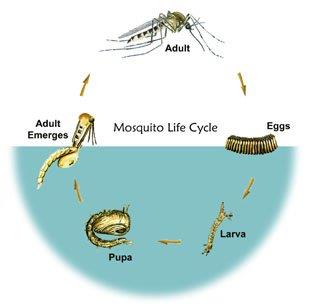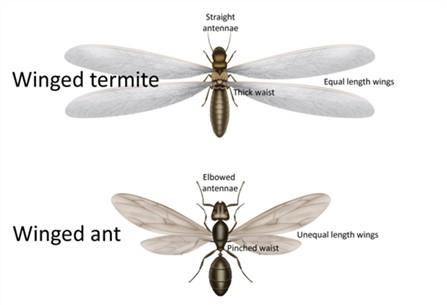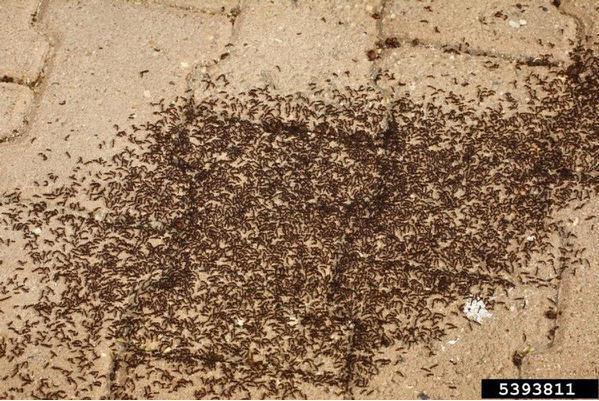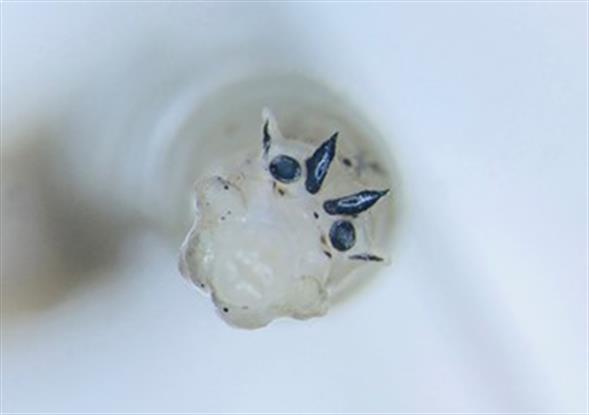
Shaku Nair and Shujuan Li
Department of Entomology, University of Arizona
A wet mild winter extending into a wet spring with warm days in between raises concerns about potential pest outbreaks later in the year. As the spring warms up, it is good to be prepared for pest infestations. Although populations are low in cold weather, mosquitoes, termites, ants, cockroaches, and filth flies are among the top pests we see increasing after wet weather in community environments in Arizona. Some of these (e.g., ants and cockroaches) are displaced from their habitats by excessive rains, leading them into homes and buildings to find food and shelter. Others, such as mosquitoes and flies, are active year-round in Arizona and thrive in wet conditions. Mosquitoes use the abundant standing water, while filth flies use the moist organic matter left behind by the receding water, as breeding sites. Termites can be active year-round in Arizona, but their swarmers emerge and disperse after rainy weather and this could lead to establishment of new colonies. This newsletter provides a quick overview of these pests and resources for further information.
Mosquitoes
All mosquitoes need water to complete their life cycle (Figure 1). Some species require very little water and can develop in a thin moisture film. Female mosquitoes usually lay eggs a few days after acquiring a blood meal. Depending on the species the eggs may be laid singly or in rafts, on the surface of water, on the sides of containers, or on damp soil. The eggs hatch into larvae or “wrigglers” that swim in the water and feed on microorganisms or decaying organic matter. Although aquatic, most mosquito larvae must come to the surface of the water to breath (with the exception of a few specialized mosquitoes). The larvae go through four growth stages called instars, in which they grow in size, before reaching the nonfeeding pupal stage. The pupae, often called “tumblers”, as they rotate within the water column, also breathe by using their respiratory “trumpets” to draw air from the atmosphere directly through the surface of the water. The pupal stage is normally quite short (1-2 days), after which the adult mosquito emerges.
The best way to prevent mosquitoes and mosquito-borne diseases is to eliminate their breeding sites. Humans create a lot of opportunities for mosquitoes to exploit. Many of us have mosquitoes developing in our neighborhood and even in our own backyards. Standing water left from rains or irrigation water will support increasing mosquito populations. Stagnant water in neglected swimming pools is another ideal habitat for many species, though mosquitoes cannot live in a well-maintained swimming pool. Some important vectors breed in “cryptic” breeding sites, utilizing very small amounts of water in tree-holes, artificial containers and even leaf axils.

Figure 1: Generalized mosquito life cycle.
(Photo: U.S. Environmental Protection Agency)
It is equally important to avoid mosquito bites, using protective clothing or personal repellents. Personal repellents are substances applied to skin, clothing or other surfaces, or accessories used to repel or discourage biting arthropods, such as mosquitoes and ticks, from feeding on humans. They include spray, lotion, and disposable towelette products and devices that can be worn or placed in an area to repel biting pests.
Check out our resources about mosquitoes and their management:
Mosquitoes: Biology and Integrated Pest Management: https://extension.arizona.edu/sites/extension.arizona.edu/files/pubs/az1706-2019.pdf
Mosquitoes and Disease Concerns: https://extension.arizona.edu/pubs/mosquitoes-disease-concerns
Mosquito and Tick Repellents: https://extension.arizona.edu/pubs/mosquito-tick-repellentsTermites
Termites are considered major structural pests, often dreaded by home and building owners because a few species attack wooden materials used to build homes and other structures. However, termites play a vital role in nature by recycling wood and other cellulose-based organic matter and returning it to the soil, enhancing soil structure with their tunneling activities. They also serve as a food source for a variety of predators in the landscape. It is very important to be aware that some common termite species are not structural pests at all.
Termites are social insects and live in organized colonies containing different castes, each performing specific functions and varying in their appearance (Figure 2). A typical colony contains a single pair or several ‘reproductives’, workers and soldiers. The reproductives or ‘alates’ are often larger than the other castes and have fully functional eyes and wings.

Figure 2: Termite workers and soldiers.
(Photo: Gary Alpert, Bugwood.org)
During favorable times of the year, usually associated with a rain event, the alates leave the colony in large numbers, often millions. This process is called “swarming” during which pairing takes place. However, only a very small number of alates survive the swarming flight. A newly formed pair shed their wings and move to a location within moist wood or soil where they will start a new colony. Workers are the most numerous. They are the individuals that are most often seen by humans causing structural damage. Termites are broadly classified into three categories based on their habitat: drywood, dampwood and subterranean.
Termites are sometimes referred to as “white ants” because of their resemblance to ants, and winged ants are often mistaken for winged termites. However, several characteristics can be seen with the naked eye that can help differentiate the two insects (Figure 3). Ants have two pairs of transparent wings of unequal size, while termites have four equal-sized wings that generally fold over the back. In addition, ants have a narrow “waist” behind their wings, but the abdomen is completely straight in termites. The antennae of ants are elbowed, whereas the antennae of termites are straight and filamentous.

Figure 3. Differences between winged ants and termites.
(Photo: Shutterstock)
Read more about Arizona termites in our Extension publications:
Arizona Termites of Economic Importance: https://extension.arizona.edu/sites/extension.arizona.edu/files/pubs/az1369.pdf
Termite Management for Homeowners:
https://extension.arizona.edu/sites/extension.arizona.edu/files/pubs/az1356.pdf
Our newsletter “Not All Termites Are Terrible” is available here.
Ants
Ants are some of the most ubiquitous insects found in community environments. They thrive indoors and outdoors, wherever they have access to food and water. Ants outdoors are mostly beneficial, as they act as scavengers and decomposers of organic matter, predators of small insects and seed dispersers of certain plants. Ant colonies vary widely with the species, and may consist of less than 100 individuals in small concealed spaces, to millions of individuals in large mounds that cover several square feet in area. Winged ants are often mistaken for winged termites that also swarm to mate and usually appear at the same time of the year, especially following rain events (see Figure 3 in section on termites above).
In general, ants are considered a nuisance mostly because of their numbers (Figure 4). They will not cause significant damage if managed in a timely manner. Outdoors, ants can protect and encourage honeydew-producing insects such as mealy bugs, aphids and scales that feed on landscape plants, and this often leads to increase in numbers of these pests.

Figure 4. An infestation of pavement ants.
(Photo: Joseph Berger, Bugwood.org)
Carpenter ants can cause damage to wooden structures by hollowing out wood. Some species such as harvester ants and fire ants can inflict painful bites and stings, and this is a cause for concern. Some species of ants, such as the red imported fire ant (not established in Arizona) escape drowning during excessive rain and flooding, by linking their bodies together to form “rafts”.
Check out our publication on fire ants: https://extension.arizona.edu/pubs/beware-fire-ant-stings
Cockroaches
Cockroaches live in a wide range of habitats and most species prefer warm, moist environments. They are mostly nocturnal and tend to hide in dark, concealed spaces during the day and feed at night. They are omnivorous and will feed on a wide variety of materials including human food, pet food, plant and animal debris, paper, cloth, cardboard and any kind of decaying organic matter. Cockroaches are extremely hardy insects and can survive adverse conditions such as limited food for extended periods of time. The problems caused by pest cockroaches often go beyond their mere presence, which itself is a cause of alarm or panic in many persons. Besides feeding and damaging food and other items, they can carry and spread a number of pathogens. Cockroaches are a leading cause of asthma and allergies in sensitive people due to the allergens produced in their bodies. Important pest species include the German, American, brown-banded and Turkestan cockroaches.
Indoor cockroaches, such as German cockroaches thrive year-round in warm, moist environments. However, during extended wet spells, outdoor species get displaced from their habitats and are drawn indoors in search of dry ground. Most common among these are the American cockroaches (sewer roaches) that frequent sewers (Figure 5) and Turkestan cockroaches that reside in irrigation boxes.

Figure 5: American cockroaches inside a sewer and a manhole lid.
(Photos: Dawn H. Gouge)
Check out our newsletter on the American cockroach for more information on their management: https://acis.cals.arizona.edu/docs/default-source/community-ipm-documents/newsletters/azhomeschoolipm-newsltrsep2022-v3.pdf
Filth Flies
Flies belong to the insect order Diptera, which is one of the most diverse insect orders and is considered to be of utmost importance economically and ecologically. Many of its members are annoying, biting pests that vector infectious diseases of humans and animals, e.g., mosquitoes (discussed above). Flies that have a particular affinity for decomposing organic matter (garbage, decaying debris and other organic waste material) are collectively referred to as filth flies. These include house flies (Figure 6), flesh flies, blow flies, drain flies, phorid flies and fruit flies. They play an important role as decomposers, but their adults are passive vectors of disease-causing microorganisms. During heavy rainfall followed by flooding, rich organic matter deposits from floodwater, flourishing vegetation and warm temperatures create the ideal environment for an outbreak of these flies.

Figure 6: Adult house fly.
(Photo: Shutterstock)
Proper waste management is the first and best step in fly management. Read more about filth flies in our past newsletters:
Flies in the Kitchen: https://acis.cals.arizona.edu/docs/default-source/default-document-library/june_july2022_vf2-azschoolandhomeipmnewletter_flies-in-the-kitchen.pdf
For comprehensive information about pest-proofing, to keep out wet weather pests and more, read our publication available here: https://extension.arizona.edu/sites/extension.arizona.edu/files/pubs/az1677-2015.pdf
The Handbook on Pests of Community Environments contains information on the different species of the above mentioned pests commonly encountered in the southwestern U.S. https://acis.cals.arizona.edu/docs/default-source/community-ipm-documents/handbook-on-pests/5-genhousehold.pdf
We’ll Take Your Ticks

The Border Tick and Rickettsia Surveillance (BiTeRS) program of the Pacific Southwest Center of Excellence in Vector-Borne Diseases (PacVec) offers services to enhance surveillance for ticks and tick-borne pathogens of human health concern in California and Arizona. This is made possible through our project leaders at the University of California, Davis, and the University of Arizona, and collaborating local and state agencies, including the California Department of Public Health and the Arizona Department of Health Services.
We help every step of the way, and identification and pathogen testing are FREE. Collection supplies and protocols are provided, and partners receive all results on ticks they have submitted.
We work with partner organizations to:Partner organizations may be:
Download the BiTeRS Flyer for distribution: https://pacvec.us/biters/

Answer: Caddisfly larva.
Caddisflies are a group of moth-like insects that can be found in all kinds of wetlands. The larvae are known for making cases to pupate in, gathering stones, sand and leaves, and wrapping them with silk. They are not pests, but large numbers can be a nuisance in homes and buildings near water bodies.
Congratulations to Master Pest Detective: Violet Wielgus,
Groundskeeping Specialist, Arizona State University.

(Photo: Rebecca Senior)
If you know the answer, email Dawn at dhgouge@arizona.edu. You will not win anything if you are correct, but you will be listed as a “Master Pest Detective” in the next newsletter issue.
Save the Date: 6th Arizona School IPM Conference
In person on April 18th and 19th, and Online April 24th – May 31st, 2023.
Registration is open through May 31st, 2023.
Registration information and schedule are available at: https://acis.cals.arizona.edu/community-ipm/events/arizona-school-ipm-conference
A great opportunity for continuing education not only for schools and childcare, but also for community colleges, city parks and rec, turf and landscape managers, golf course supervisors, and other institutional staff engaged in operations, maintenance, turf and landscape, food service, health services and many other areas. The online format makes it accessible to persons anywhere in Arizona and other states. 6 and 12 PMD/PUG/PUC CEUs will be available for license renewal.
Have a question? Call 602-827-8214 or email nairs@arizona.edu.
_____________________________________________________________
Save the Date: 32nd Desert Horticulture Conference
Friday, May 5, 2023, at the El Conquistador Hotel, Tucson.
The Desert Horticulture Conference is the premier annual conference for all members of the southwest green industry: landscape architects, designers, growers, retailers, contractors, maintenance personnel, suppliers, and educators. Presenting timely and research-based information relevant for designing, building, maintaining, and producing plants for urban landscapes in the arid Southwest. The conference offers three concurrent tracks: Plants and Design, Plant Health, and Water/Urban Landscapes. For registration and further information: https://cals.arizona.edu/deserthort/
___________________________________________________________
What’s Bugging You? First Friday Events (New York State IPM Program)
Fridays | 12:00 pm. – 12:30 p.m. EDT | Zoom | Free; registration required
The first Friday of each month, spend half an hour over lunch learning about practical solutions for pest problems with the New York State IPM Program. Each presentation will end with an IPM Minute. https://nysipm.cornell.edu/whats-bugging-you/first-friday-events/
Upcoming First Friday Events:
____________________________________________________________
Urban and Community IPM Webinars
Host: University of California
UC Statewide IPM Program Urban and Community webinar series is held the third Thursday of every month to teach about pest identification, prevention and management around the home and garden. This series is free but advanced registration is required. Dates and topics below, all begin at noon Pacific. https://ucanr.edu/sites/ucipm-community-webinars/
Upcoming webinars:
_____________________________________________________________
EPA Webinars about Integrated Pest Management
The EPA Center of Integrated Pest Management hosts a webinar series featuring national experts from across the country relaying educational and practical strategies for establishing and improving integrated pest management programs in buildings. We invite you to review the information on the past topics. Register for new or review archived IPM webinars Upcoming Integrated Pest Management Webinars | US EPA
Upcoming webinar:
Newer Tools in Mosquito Management – UAVs and ATVs
Mosquito control districts are increasingly using unmanned aerial vehicles (UAVs) and all-terrain vehicles (ATVs) as both monitoring tools and for applying pesticides. This webinar will explore how these technologies are evolving and becoming integrated into mosquito management programs. Federal and local experts will also discuss potential limitations and regulatory challenges with UAVs and ATVs. Registration information coming soon.
View recordings of previous EPA Integrated Pest Management Webinars at https://www.epa.gov/managing-pests-schools/upcoming-integrated-pest-management-webinars.
For more information about the EPA Schools program: http://www.epa.gov/schools/.
To view all our previous newsletters, visit: https://acis.cals.arizona.edu/community-ipm/home-and-school-ipm-newsletters.
Acknowledgements
This material is in part funded by the National Institute of Food and Agriculture, U.S. Department of Agriculture, under award number 2021-70006-35385 that provides Extension IPM funding to the University of Arizona. It is funded in part by the USDA National Institute of Food and Agriculture through the Western Integrated Pest Management Center, grant number 2018-70006-28881. Additional support is provided by the UA Arizona Pest Management Center and Department of Entomology. Any opinions, findings, conclusions, or recommendations expressed in this publication are those of the authors and do not necessarily reflect the views of the U.S. Department of Agriculture or those of other funders.